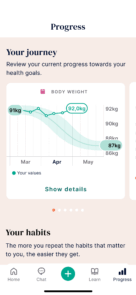
How to lose belly fat (from a dietitian)
Want to know how to get rid of belly fat? In truth, there’s no evidence-based method for specifically targeting fat in the abdomen, but you’ll naturally lose belly fat as you reduce your overall body weight.
You can do this by making realistic changes to your diet, exercise, habits and lifestyle. The key is to avoid extreme methods in search for extreme results – they’re too hard or even dangerous to maintain long term.
Oviva is a weight management programme that offers expert guidance, weight loss medication, plus an app for tracking progress and communicating with your coaching team.
Key Takeaways
- There are no effective ways to target belly fat alone, but you can reduce your abdominal fat by lowering your overall body weight.
- Various factors influence how fat is distributed across the body, including genetic factors and age.
- The best way to lose weight is to adopt sustainable behavioural changes, such as improving the quality of your diet and the amount of exercise you get.
- Oviva can help you adopt a healthy and sustainable weight loss plan and provide access to weight loss medication like Wegovy.
Losing belly fat
In the sections that follow, you’ll find helpful tips on how to reduce belly fat for health:
1. Ignore myths about spot-reducing fat
A crucial first step is acknowledging that all claims you can specifically target belly fat are myths, regardless of whether the claim focuses on diet or exercise.
There are no proven methods for reducing belly fat in isolation. Instead, you’ll need to reduce your overall body weight. You’ll begin to lose inches from your abdominal region as you lose weight.
2. Make sustainable changes to your diet
Sustainable changes to your diet are at the core of how to burn belly fat. Sustainability is key here because these changes should be long-term, as opposed to drastic changes that you cannot keep up with.
This means eating a diet rich in nutrients which are the best foods for weight loss, including fibre and lean protein. If you’re not sure where to start, our 7-day healthy diet plan gives you a week of meal plans and recipes to follow, created by dietitians.
Try to replace most ultra-processed foods and unhealthy snacks in your diet with healthier alternatives. For example, veggie sticks and hummus for a savoury option or apple slices with a little peanut butter for something sweet.
When it comes to how to stick to a diet, approach nutrition as a long-term lifestyle change rather than a short-term fix and avoid skipping meals, as this can lead to overeating later in the day.

3. Increase your level of physical activity
Find ways to increase physical activity. The NHS recommends 150 minutes of moderate-intensity or 75 minutes of vigorous exercise weekly for a typical adult. But this is just like dietary changes – making drastic overnight alterations isn’t sustainable. Instead, think about ways you can gradually build up your exercise. Could you start by taking a 20-minute walk a few times a week?
Contrary to online myths, there’s no evidence to show that focusing on abdominal-related exercises will target belly fat. It’s best to prioritise strength training and aerobic exercise if possible, but even simple increases to the amount you move around the house can be beneficial.
4. Consider using weight loss medication
Obesity treatments like Wegovy and Saxenda are effective for weight loss when combined with lifestyle changes relating to diet and exercise. These weight loss injections are available on the NHS if you’re eligible for an approved weight management programme like Oviva.
Oviva patient success stories:

 -22kg
-22kg
Heidi (53)

 -25kg
-25kg
Martin (34)

 -32kg
-32kg
Patricia (53)
How long does it take to lose belly fat?
The rate at which you’ll lose belly fat is unique to you, as it’s different for everyone. Some people carry more weight around their midsection than others, and contrary to some claims online, there are no proven ways to target your stomach for weight loss specifically.
It’s also best not to become overly fixated on the speed of weight loss but to adopt sustainable weight loss methods over the long term. This means avoiding crash diets unless medically supervised and prioritising lifestyle changes that you can continue to follow.
NHS guidelines recommend aiming for weight loss of 1-2 lbs (0.5-1 kg) per week. However, it’s important to stress that this is general advice, and your weight loss speed may differ for various reasons, including medical conditions that may make weight loss more challenging.

What causes belly fat?
The underlying cause of belly fat is excess weight, but the specific distribution of fat on your body is influenced by several factors, including:
- Genetics
- Age
- Biological sex (e.g. those born male are more likely to accumulate abdominal visceral fat)
Everybody is different, and two people living with similar levels of overweight or obesity may have vastly different amounts of belly fat, as well as fat, in other locations.
While diet and activity levels are key contributors to weight gain, genetics will typically determine where you show signs of weight gain, with some of the most typical locations including the abdomen, thighs, arms and bottom.
Stigmatising belly fat is unhelpful and can be upsetting – people cannot directly control where fat accumulates in the body.
How losing belly fat can support our health
Losing belly fat, like other forms of fat, can support health by reducing the risk of numerous health conditions like type 2 diabetes, coronary heart disease and some types of cancer. However, it becomes even more important to lose belly fat if it’s visceral fat.
The difference between subcutaneous fat and visceral fat
Belly fat can be separated into subcutaneous fat and visceral fat. Subcutaneous fat is the type you can pinch and lies just below the skin. Conversely, visceral fat is found deeper within the abdominal cavity and around the abdominal organs.
Losing any excess body weight and fat is valuable, but visceral fat is particularly implicated in severe health conditions like type 2 diabetes, cardiovascular disease and certain cancers. Choosing the best foods for weight loss can help reduce subcutaneous and visceral fat.

How we can help
The key to how to lose belly fat is to adopt sustainable weight loss methods, and Oviva can help you develop a plan to implement sustainable lifestyle changes.
Oviva is a tier 3 weight management programme that provides expert advice, personalised care and weight loss medication for people living with obesity. Our team includes doctors, dietitians, nurses, psychologists and other healthcare professionals.
You can ask your doctor for help with weight loss by requesting a referral if you meet the eligibility criteria. Criteria usually includes a body mass index (BMI) over 35 and at least one weight-related health condition. If you’re unsure of your BMI, you can use our free BMI calculator.








